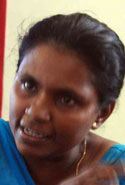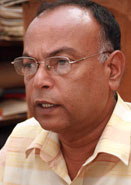| It would be sweaty afternoons and uncomfortable nights for Sri Lankans throughout April, the Meteorological Department said yesterday. “The Sun will be directly above Sri Lanka on Tuesday and this is the cause of a prolonged heat wave,” Anusha Warnasuriya, the department’s Climate Change Studies chief said.
 |
 |
| Anusha Warnasuriya |
Prof. S. Anthony Norbert |
She said this was the inter-monsoonal period and the heat would recede with the onset of the south west monsoon next month.
Ms. Warnasuriya said the main characteristic of this monsoon in May would be high temperature during the daytime and thunderstorms or scattered showers at nights. “This year there are no strong winds blowing from the south west direction therefore coastal areas will experience humidity as well.”
She said the World Meteorological Centre had identified the period from 2001 to 2010 as the warmest decade and 2010 as one of the warmest years in recent times. This year Northern, North-Central and North-Western provinces would experience high temperatures with an increase of five to 10 degrees.
“Lightning and thunder would also occur during April and May. Therefore, people should be more cautious, especially while being outdoors during holiday season,” Ms. Warnasuriya said.
Prof. S. Anthony Norbert of the Department of Geography at Colombo University said as there were extreme weather changes which caused floods earlier this year, during the inter-monsoon season there could be mini-cyclones, storms and changes in temperature.
“When the landmass is warm there is excessive evaporation, resulting in a moisture saturated atmosphere. When the body produces sweat due to humidity, the sweat does not evaporate. This will cause dehydration, skin rashes, discomfort, depression, lack of sleep and increase in stress levels,” he said. Medical professionals too advice public to be wary of illnesses caused by the hot weather.
Dr K. Sathgurunathan, consultant dermatologist at the National Hospital said, during warm months Miliria (prickly heat) was common among children.
“Clothes should not be worn tight as it causes discomfort, sweat and result in prickly heat and dermatitis. It is advised to wear cotton clothing,” he said adding that sweat rashes could be prevented by applying lotions that contain calamine or menthol.
Dr. Shanthi Gunawardene, director of the Nutrition Coordination Division of the Health Ministry said it was important to increase the intake of fluids such as water, coconut water and juices made from citrus fruits like oranges, lime and lemon.
“Children are more vulnerable to dehydration especially after being exposed to the sun during sport meets and holidays. Apart from liquids, their meals should include a bit starchier food like rice and rice-based products, grams, potatoes and bread as they produce energy. It is important to take vitamins, potassium and minerals through fruits as excessive sweating results in losing of minerals,” she said.
Dr. Gunawardene said carbonated and chilled drinks should be avoided as viral infections in the throat were reported during the last few weeks.
Dr. Sisira Liyanage, Director of Eye Hospital in Colombo, said there was a possibility of ultraviolet rays affecting the eyes especially among those who are exposed to the sun for a long period of time.
“Sunglasses filter ultraviolet rays. In developed countries sunglasses are recommended even for children when travelling in the sun. Wearing sunglasses soothes the eyes while driving or walking and even comes as a remedy for headaches that worsens when exposed to the sun.” |



